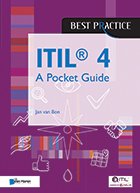Check out this free chapter excerpt from ITIL 4 -- A Pocket Guide
In ITIL 4 -- A Pocket Guide, author Jan van Bon walks readers through the core updates to the ITSM framework, and how they apply to the modern enterprise IT landscape.
IT standards and frameworks should evolve as quickly as the technology they govern. But sometimes, IT software tools and practices change more rapidly than frameworks can adjust: ITIL is a well-known instance of this lag.
ITIL 3 was last updated in 2011, and ITIL 4 was greatly delayed until its release in Q1 2019.
While not everything has changed in the IT service management (ITSM) framework, ITIL 4 has seen a number of additions and adjustments to accommodate distributed architectures and DevOps practices. Jan van Bon captures the framework's first major update in eight years with ITIL 4 -- A Pocket Guide, the newest addition to Van Haren Publishing's extensive Pocket Guide list, which covers topics from Agile to a variety of coding languages. This guide presents the updates and changes in the ITIL 4 framework, as well as the core concepts a reader must know to pass the certification exam -- a key tenet of the book series.
"I've always tried to ... make it simpler for people to [grasp] the idea of what these books are about," said van Bon, author of ITIL 4 -- A Pocket Guide. The goal is to make a complex topic accessible to a broader audience from a foundation level -- and there's a lot to know about this framework's update.
"As usual, it's completely reconstructed," he said.
Key updates to ITIL

This total reconstruction is one of the two most important aspects of the ITIL 4 update for van Bon; the ITIL Change Advisory Board for v3 in 2007 -- of which he was a member -- offered recommendations for the update that went unheeded. But this update to ITIL 4 resolved an expansive poll of experts and academics in the field that produced a variety of modern service management tactics. The v4 update, including its service-dominant logic, aligns with these modern views, van Bon writes:
With the new ITIL 4, a major step has been taken to cover the latest developments. The ITIL 4 guidance supports modern ways of co-creating value in an active collaboration of stakeholders, using an Agile approach in a customer-focused setting. Its holistic approach not only underpins the management of IT services, but now also supports other domains, enabling the integration of IT with the business and with other support domains.
The second most important item, according to van Bon, is a written statement in ITIL 4 that clarifies everything referred to as a process in prior versions was instead a practice -- a point every organization must understand to be successful with ITIL. IT organizations have sought out proven examples of ITIL success, but the difference between practice and process has been uncertain for two decades, he said. ITIL defines a practice as "a set of organizational resources designed for performing work or accomplishing an objective," whereas process maps onto ITIL's guiding principles: "recommendations that can guide an organization in all circumstances, regardless of changes in its goals, strategies, type of work, or management structure."
ITIL 4 expanded its list of practices from 28 to 32, and redefined many existing practices. This makes it easy to get lost, van Bon said. But ITIL 4 is heavily influenced by academic conversations and real-world experience. "It's the usual container of practical examples [and] practical ways of working that you could be inspired by, in trying to create your own service organization in the best way you can."
While ITIL provides a set of service management best practices, each IT organization must forge and implement its own system using the framework as a guide. "[Try] to develop something that makes sense as a system, and then look at the ITIL [set of] best practices," van Bon said.
Rather than a service management system, think of ITIL 4 as a service value chain. It's abstract, which enables organizations to allocate activities as necessary to meet their own success.
"If you [combine] a management system view with the service value chain descriptions and [ITIL best practices], you [have] a perfect fit," van Bon said.
Editor's note: This excerpt is from ITIL 4 -- A Pocket Guide, authored by Jan van Bon, published with Van Haren Publishing, April 30, 2019, ISBN: 9789401804394. To read chapter one -- the introduction -- and part of chapter 2 from the book, click here.







